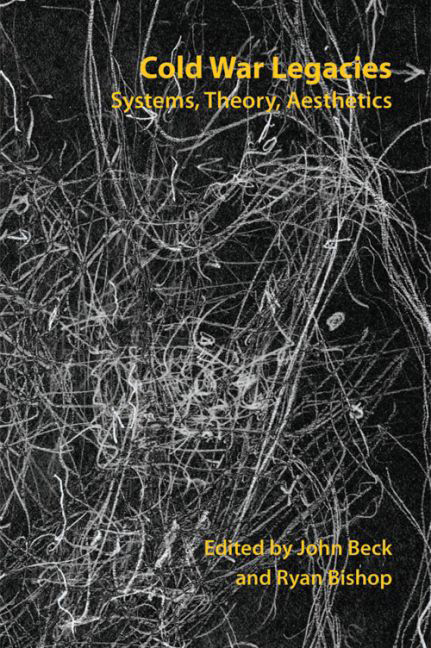Book contents
- Frontmatter
- Contents
- List of Figures
- Series Editors’ Preface
- Acknowledgements
- Notes on Contributors
- Introduction: The Long Cold War
- I PATTERN RECOGNITION
- II THE PERSISTENCE OF THE NUCLEAR
- 4 The Meaning of Monte Bello
- 5 Deep Geological Disposal and Radioactive Time: Beckett, Bowen, Nirex and Onkalo
- 6 Shifting the Nuclear Imaginary: Art and the Flight from Nuclear Modernity
- 7 Alchemical Transformations? Fictions of the Nuclear State after 1989
- III UBIQUITOUS SURVEILLANCE
- IV PERVASIVE MEDIATIONS
- Index
6 - Shifting the Nuclear Imaginary: Art and the Flight from Nuclear Modernity
from II - THE PERSISTENCE OF THE NUCLEAR
Published online by Cambridge University Press: 10 May 2017
- Frontmatter
- Contents
- List of Figures
- Series Editors’ Preface
- Acknowledgements
- Notes on Contributors
- Introduction: The Long Cold War
- I PATTERN RECOGNITION
- II THE PERSISTENCE OF THE NUCLEAR
- 4 The Meaning of Monte Bello
- 5 Deep Geological Disposal and Radioactive Time: Beckett, Bowen, Nirex and Onkalo
- 6 Shifting the Nuclear Imaginary: Art and the Flight from Nuclear Modernity
- 7 Alchemical Transformations? Fictions of the Nuclear State after 1989
- III UBIQUITOUS SURVEILLANCE
- IV PERVASIVE MEDIATIONS
- Index
Summary
Shortly after the bombing of Hiroshima and Nagasaki, László Moholy-Nagy captured the emerging nuclear imaginary in Nuclear I, CH(1945), a painting that depicts a nuclear world balanced on the modern grid of Chicago. The grid pattern over which the nuclear sphere hovers is probably inspired by the aerial view of the city Moholy-Nagy witnessed during a mission to consider how to camoufl age landmarks, a practice the atomic bomb rendered useless (Engelbrecht 2009: 639). The painting shifts in scale, from the monochrome urban plan to the global nuclear condition, where the world is exposed to the full light spectrum of the atomic explosion. The grid is a paradigmatic sign of modernity, its infinitely extendable, mathematical partitioning of space emblematic of Enlightenment rationality and the implicit mastery of the physical world that stems from it. In contrast, the organic ‘bubble’ earth seems less solid and more fragile, yet it also signals a complete, closed environment. Moholy-Nagy's painting is significant not just because it is one of the first artworks of the atomic age but because it instantiates a set of spatial relations among the bomb, the position of the observer, and the planet that will come to characterise the discourse of nuclear politics in subsequent decades. The painting situates the artist and viewer in the elevated, and thus removed, position of the pilot (a position of removal that is also one of complicity), a vantage point from which the nuclear explosion can be apprehended as sublime spectacle and not as an act of mass destruction. The target is abstracted so that there is no detailed information on the structures and populations destroyed, only the gridded information as surveyed from above. And finally, the event of the detonation is represented as world-making – it defines and encompasses the ‘whole earth’: from inside this world, the effects and knowledge of the nuclear cannot be undone.
The purpose of this chapter is to consider artistic practices that continue to grapple with the implications of the nuclear perspective outlined in Moholy-Nagy's painting. The predominant existential and political issues surrounding the ‘nuclear’ are no longer focused on nuclear weapons as such, although proliferation remains a persistent concern. Especially in the aftermath of the 2011 Fukushima Dai-ichi Nuclear Power Plant disaster, nuclear crisis has come to mean catastrophic accident rather than military conflict. Yet the coordinates of the nuclear spatial imaginary remain disturbingly consistent.
- Type
- Chapter
- Information
- Cold War LegaciesLegacy, Theory, Aesthetics, pp. 116 - 133Publisher: Edinburgh University PressPrint publication year: 2016



